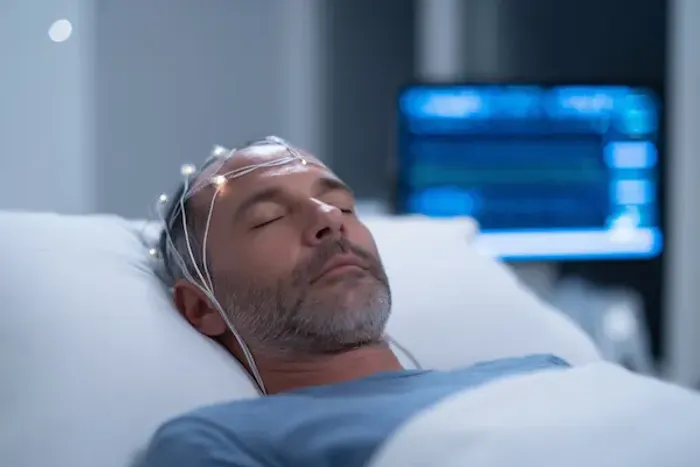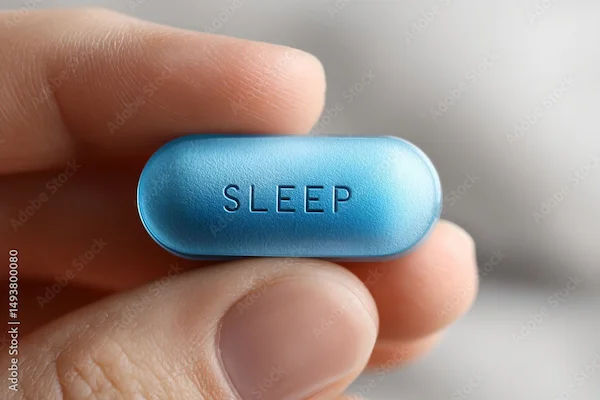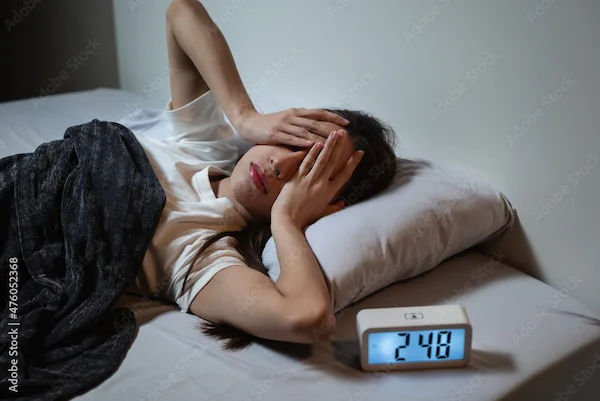Guide to Interventional Neurology/importance Sleep Brain Health
Explore the vital link between cutting-edge interventional neurology and nightly sleep for optimal brain health. Learn how minimally invasive procedures treat conditions like stroke and aneurysms, and why 7–9 hours of quality sleep acts as your brain’s natural repair and prevention system.


Introduction
Sleep isn’t just “rest.” It’s active maintenance for your brain—clearing waste, repairing connections, and strengthening memory. At the same time, breakthroughs in interventional neurology are saving lives and reducing disability from stroke, aneurysms, and other brain vessel problems—often in minutes. This guide brings these two worlds together: how expert, minimally invasive brain care works, and why your nightly sleep is a surprisingly powerful partner in brain health and recovery.
We’ll explain what interventional neurology is, how time-critical procedures like mechanical thrombectomy restore
blood flow during stroke, and how sleep disorders such as sleep apnoea raise your risk. You’ll learn practical sleep strategies to protect your brain, what to expect if you or a loved one needs a neurointerventional procedure, and how better sleep can boost recovery afterwards. Because you searched for “brain, interventional, neurology/importance,” we’ve organised this guide to be easy to skim and act on—grounded in respected medical sources and real-world examples.
Consult Top Neurologists for Personalised Advice
What Is Interventional Neurology?
This speciality uses image-guided catheters to treat brain and spine vessel conditions without traditional open surgery.
Interventional neurology (also called neurointerventional surgery or endovascular neurosurgery) uses image-guided
catheters and tiny tools passed through your blood vessels to diagnose and treat brain and spine conditions without
open surgery. Instead of opening the skull, a specialist threads a soft, flexible catheter from an artery in the wrist or
groin up to the brain using live X-ray guidance.
Conditions Commonly Treated
- Ischaemic stroke: A clot blocking blood flow to part of the brain.
- Intracranial aneurysms: Weakened vessel “bulges” at risk of rupture.
- Arteriovenous malformations (AVMs) and dural arteriovenous fistulas: Abnormal connections between arteries and
veins. - Carotid artery disease: Narrowing that can shed clots to the brain.
Compared with traditional surgery, interventional approaches can mean smaller incisions, often shorter hospital stays,
and faster recovery for the right patients. The field blends neurology, neurosurgery, and radiology—focused on getting
blood flow where your brain needs it, when it needs it most. If you searched for brain, interventional,
neurology/importance, this is the heart of it: minimally invasive treatments that can be life-sparing and disability-
reducing.
Unique Insight: Think of interventional neurology like “cardiology for the brain.” Just as cardiologists use stents and
catheters to open heart arteries, neurointerventionalists restore or reroute blood in delicate brain vessels—often under
extreme time pressure
How Sleep Keeps Your Brain Healthy
Quality sleep activates the glymphatic system, which clears metabolic waste and supports long-term neuronal repair.
Sleep is active brain work. During deep and REM sleep, your brain strengthens certain synapses, prunes others, and
“consolidates” memories—helping you learn new skills and stabilise mood. Just as important, research shows that the
brain’s glymphatic system—the plumbing that clears metabolic waste—works far more effectively during sleep, when
brain cells contract slightly and channels open to wash out byproducts like beta-amyloid. That nightly rinse keeps
inflammation down and helps maintain neuronal health.
Recommended sleep for most adults is 7–9 hours per night, per AASM and CDC guidance. Too little sleep (under 6
hours) or chronically broken sleep can raise blood pressure, worsen insulin resistance, increase stress hormones, and
impair attention—each of which can strain the brain. Understanding glymphatic clearance during sleep clarifies why
consistent, high-quality rest is a pillar of brain health—not a luxury.
Unique Insight: Many people focus on total sleep minutes but overlook sleep regularity. Going to bed and waking up at
roughly the same time daily helps anchor your circadian rhythm—supporting not only memory and mood but also
vascular function that protects your brain.
Stroke —Symptoms You Should Never Ignore
Immediate action is crucial, as every minute of untreated stroke costs the brain an estimated 1.9 million neurons.
Every minute of untreated stroke costs the brain roughly 1.9 million neurons. Learn BE FAST:
- Balance: sudden loss of balance or coordination
- Eyes: sudden vision loss or double vision
- Face: drooping on one side
- Arm: weakness or numbness on one side
- Speech: slurred or trouble speaking
- Time: call emergency services immediately
“Last-known-well” is the time you were last symptom-free. It’s vital because some treatments hinge on this clock.
Wake-up strokes—discovered on awakening—are common; advanced imaging can still identify salvageable brain tissue
and guide treatment even when exact timing is uncertain. Never drive yourself; call an ambulance to reach a stroke-
ready centre fast. If symptoms resolve quickly, that may be a transient ischaemic attack (TIA), a warning shot that
deserves urgent evaluation to prevent a major stroke. If symptoms persist beyond two weeks (for non-emergency issues
like lingering dizziness or headaches), consult a doctor online with Apollo 24|7 for further evaluation, or seek urgent
care immediately for BE FAST symptoms.
Unique Insight: Programme emergency contacts into your phone as “ICE” and teach family the BE FAST checklist.
Seconds saved can be life-changing.
Interventional Stroke Care—From Clot to Cure
Rapid, minimally invasive procedures can physically remove a clot and restore critical blood flow to the brain.
Two treatments dominate modern ischaemic stroke care:
- Thrombolysis: a clot-busting medication (tPA or tenecteplase) given intravenously within hours of symptom onset.
- Mechanical thrombectomy: a catheter-based procedure using a stent retriever or aspiration device to physically remove
a large clot from a brain artery.
Landmark trials showed that thrombectomy for large-vessel occlusions dramatically improves chances of independence
at 90 days. Later trials expanded the treatment window to as long as 16–24 hours in carefully selected patients using
perfusion imaging to identify salvageable brain tissue. In practice, teams move with precision: rapid imaging, neurologic
exam, decision on lysis and/or thrombectomy, then straight to the angio suite.
What to Expect
You’ll lie on an X-ray table; a catheter is inserted at the wrist or groin under local anaesthesia and sedation. The doctor
navigates to the clot, deploys a device to grab or aspirate it, then restores flow—often in under an hour. Risks include
bleeding, vessel injury, and contrast reactions, but in the right patients, benefits are significant: better functional
recovery and lower disability.
Unique Insight: Ask whether your local hospital is a thrombectomy-capable (or comprehensive) stroke centre and how
they coordinate transfers—knowing this ahead of time can shave critical minutes if an emergency arises.
Sleep and Stroke Risk—The Hidden Links
Sleep apnoea and chronic short sleep are major, under-recognised risk factors for stroke and heart disease.
Sleep apnoea is a major, under-recognised stroke risk. Repeated airway collapse at night causes drops in oxygen
(nocturnal hypoxia), surges in blood pressure, and inflammation that injures blood vessels. Untreated moderate-to-
severe obstructive sleep apnoea (OSA) is associated with roughly doubled risks of stroke and heart disease; treating
OSA with CPAP can lower blood pressure and may reduce stroke recurrence.
Insomnia and short sleep (under 6 hours) are linked to hypertension, atrial fibrillation, diabetes, and depression—all
stroke risk factors. Fragmented sleep can worsen endothelial function and increase arterial stiffness. Small vessel
disease, visible as white matter hyperintensities on MRI, is more common with OSA and chronic sleep disruption, tying
sleep directly to “brain plumbing” health.
What to Do
If you snore loudly, wake choking, have morning headaches, or feel excessively sleepy, ask your clinician about a home
sleep apnoea test or in-lab polysomnogram. Apollo 24|7 can coordinate referrals and offer convenient home collection
for related tests (such as HbA1c or lipid panels) relevant to vascular risk.
Unique Insight: Even a modest 10% weight loss can meaningfully improve mild OSA, potentially reducing nightly
oxygen dips that strain brain vessels.
Aneurysms, AVMs, and Endovascular Treatments
Interventional techniques use coils or flow diversion devices to secure weakened or abnormally connected blood vessels.
Not all brain vessel problems are clots. Aneurysms are balloon-like bulges that can rupture and cause bleeding in the
brain (subarachnoid haemorrhage). Many can be treated endovascularly with coiling—packing the aneurysm with tiny
platinum coils—or with a flow-diverter stent that reroutes blood away from the aneurysm to promote healing. For
AVMs and dural fistulas, embolisation uses liquid agents or coils to close abnormal connections.
Deciding between observation, coiling, clipping (surgery), or flow diversion depends on aneurysm size, shape, location,
rupture status, and patient factors. For ruptured aneurysms, rapid securement is crucial to prevent rebleeding. For
unruptured aneurysms, teams balance rupture risk against procedural risk. Outcomes at experienced centres are
excellent for appropriately selected cases, and recovery is often faster than with open surgery.
Unique Insight: Ask about your aneurysm’s “neck” shape and location—these technical details often determine whether
coiling alone, stent-assisted coiling, or flow diversion is best.
Sleep’s Role in Recovery and Neuroplasticity
Protecting sleep after a neurological event helps the brain rewire itself, consolidating new learning and motor skills.
Recovery after a stroke or brain procedure relies on neuroplasticity—your brain’s ability to rewire and form new
connections. Sleep strengthens this process. Studies link sleep spindles (brief bursts of brain activity during stage 2 sleep)
to motor learning, and patients who sleep better after therapy sessions consolidate gains more effectively. Treating OSA
with CPAP after stroke can improve daytime alertness, enable fuller participation in rehab, and may enhance blood
pressure control—all factors that support better outcomes.
Practical Strategies
- Schedule therapy earlier in the day and protect a consistent bedtime to “lock in” new skills.
- Limit late-evening screens and caffeine; consider a short, early afternoon nap (20–30 minutes) if fatigue is high.
- Work with your clinician on insomnia; cognitive behavioural therapy for insomnia (CBT-I) is first-line and outperforms
sleep pills long-term.
Unique Insight: Keep a simple “rehab + sleep” journal. Note therapy tasks learned that day and sleep quality at night—
you’ll often see stronger next-day performance after better sleep.
Your Care Team: From ER to Cath Lab to ICU
Interventional care involves a rapid, multidisciplinary team dedicated to time-critical diagnosis and treatment.
A typical interventional neuro care pathway includes:
- Emergency/triage: Rapid neurologic exam, CT/MRI, labs
- Vascular neurology: Determines eligibility for lysis/thrombectomy
- Neurointerventionalist: Performs the procedure
- Anaesthesiology: Sedation or general anaesthesia as needed
- ICU/stroke unit: Monitors blood pressure, brain swelling, and complications
- Rehab team: Physical, occupational, and speech therapy start early
Many systems enable tele-stroke consults so a stroke specialist can guide treatment even from afar. Expect standardised
protocols to compress decision times. After discharge, follow-up appointments check recovery, medications, and risk-
factor control. Bring questions, medication lists, and any sleep concerns—post-stroke sleep issues are common and
treatable.
Unique Insight: Ask who will coordinate your care after discharge—the best programmes give you a single point person
to simplify appointments, medications, and therapy scheduling.
Safety First—Risks, Radiation, and Dye
Expert teams use careful protocols, imaging, and monitoring to minimise risks associated with catheter-based
procedures.
All procedures carry risks. For catheter-based brain procedures, the main ones are:
- Bleeding in the brain (haemorrhage)
- Vessel injury or dissection
- Stroke from clot migration
- Contrast dye reactions and kidney stress
- Radiation exposure from X-ray guidance
Experienced teams mitigate these risks with careful imaging, heparinisation, short fluoroscopy times, and hydration
protocols. If you’ve had contrast allergies or have reduced kidney function, tell your doctor; premedication or alternative strategies may be used. Access via wrist (radial) or groin (femoral) has different trade-offs—radial access may reduce bleeding at the entry site and allow earlier mobility.
Unique Insight: Ask for your “contrast and radiation dose” to be recorded in your discharge summary—useful for
future care and peace of mind.
Day and Night Prevention—Protecting Your Brain
Effective stroke prevention requires both consistent management of vascular risk factors and prioritising restorative
sleep.
Stroke prevention is 24/7. Daytime actions:
- Control blood pressure, blood sugar, and cholesterol
- Don’t smoke; limit alcohol; move your body daily
- Take prescribed antiplatelet or anticoagulation medications as directed
Night-time actions:
- Prioritise 7–9 hours of consistent sleep
- Keep a wind-down routine and cool, dark, quiet bedroom
- Limit late heavy meals and alcohol; avoid screens 1 hour before bed
- If snoring or excessive sleepiness persists, seek testing for OSA
A home BP cuff and a sleep diary can expose patterns. Apollo 24|7 offers convenient home collection for tests like lipid
panels, HbA1c, and vitamin D to round out your prevention plan.
Unique Insight: “Chronotherapy” matters—taking certain BP meds in the evening (if advised by your clinician) can
improve night-time blood pressure, which is closely tied to stroke risk.
Technology and the Future
Innovations like AI, mobile units, and advanced imaging are constantly improving rapid stroke response and patient
outcomes.
Innovation is accelerating:
- AI triage reads CT scans in minutes and alerts teams
- Mobile stroke units bring CT scanners and thrombolysis to neighbourhoods
- Extended treatment windows based on perfusion imaging save more brains, not just more time
- Robotics and remote neurointervention are being explored to reach rural hospitals safely
- Smarter wearables estimate sleep stages, oxygen dips, and atrial fibrillation—flagging risk sooner
As these advances spread, expect more precise selection for thrombectomy and earlier detection of sleep and heart
rhythm issues that drive brain risk.
Unique Insight: Pair your smartwatch sleep/heart data with a shared log for your clinician—when combined with
symptoms, it can fast-track targeted testing.
Preparing for a Procedure—Questions to Ask
Before a procedure, understanding the goals, risks, and recovery plan helps manage anxiety and improve outcomes.
- What is the goal—opening a blocked artery, repairing an aneurysm, or closing an abnormal vessel?
- What are the risks and benefits for me specifically?
- What sedation will I receive? How long will I stay in hospital?
- Which meds should I stop or continue (especially blood thinners, diabetes meds)?
- How should I sleep the night before? Aim for a normal bedtime; avoid heavy meals and alcohol. After the procedure,
prioritise rest and follow positioning/activity guidance.
Bring all medication bottles, an allergy list, and a support person’s phone number. Ask how to reach the on-call team for new headaches, weakness, vision/speech issues, or access-site problems.
Unique Insight: Request a plain-language summary of the procedure and expected sensations—knowing the steps can
reduce anxiety and improve sleep both before and after.
Myths vs Facts
Separating common misconceptions from evidence-based facts is essential for making informed health decisions.
- “If symptoms go away, I’m fine.” Myth. TIAs predict higher short-term stroke risk—seek urgent care.
- “I can catch up on sleep on weekends.” Myth. Irregular sleep harms circadian rhythm; consistency beats binge sleep.
- “Thrombectomy only works in the first 3 hours.” Myth. With modern imaging, selected patients benefit up to 16–24
hours after onset. - “I don’t snore, so I can’t have sleep apnoea.” Myth. Not everyone with OSA snores loudly; daytime sleepiness and
morning headaches also matter.
When to Seek Help
Recognising when to seek urgent care for neurological red flags versus when to consult a specialist for chronic sleep
issues is critical.
Red flags for sleep disorders:
- Loud snoring, choking/gasping at night, witnessed apnoeas
- Morning headaches, dry mouth, severe daytime sleepiness
- Insomnia that persists 3+ nights/week for 3 months (chronic insomnia)
Red flags for neurological emergencies (call emergency services):
- Any BE FAST symptoms
- Sudden severe “thunderclap” headache (possible aneurysm rupture)
- New seizures or confusion
If your condition does not improve after trying these methods, book a physical visit to a doctor with Apollo 24|7. For
ongoing sleep issues or risk evaluation, consult a doctor online with Apollo 24|7 for further evaluation and referrals.
Conclusion
Your brain thrives on flow and rhythm. Interventional neurology restores blood flow in emergencies and repairs fragile
vessels with remarkable precision. Sleep supplies the rhythm—steadily consolidating memories, clearing waste, and tuning the systems that keep your brain’s vessels healthy. Together, these advances and habits can dramatically shift your odds toward a longer, sharper, more independent life.
If you remember one thing, make it this: act fast for BE FAST symptoms and act consistently for sleep. Know where your nearest thrombectomy-capable stroke centre is and build a simple sleep routine you can stick to most nights. If you snore, wake unrefreshed, or feel excessively sleepy, don’t dismiss it—screening for sleep apnoea and treating it can protect your brain as surely as blood pressure control or statins. Likewise, if you live with high-risk conditions, schedule check-ins, keep your medications current, and ask about home monitoring to catch changes early. Should questions arise or symptoms persist, consult a doctor online with Apollo 24|7 or arrange a visit for tailored guidance and testing. Your best brain health combines rapid response when seconds count with nightly care when you drift off to sleep.
Consult Top Neurologists for Personalised Advice
Consult Top Neurologists for Personalised Advice

Dr. Aditendraditya Singh Bhati
Neurosurgeon
21 Years • MBBS(2004), DNB Neurosurgery(2014); MNAMS; Fellow Skull Base Endoscopy (Italy), Fellow Extended Skull Base ( Weill Cornell, USA), Fellow ZAP-X Radiosurgery. Member of American Association of Neurological Surgeons
Delhi
Apollo Hospitals Indraprastha, Delhi
(100+ Patients)

Dr. Ganeshgouda Majigoudra
Neurologist
10 Years • MBBS, MD ( GENERAL MEDICINE) DM (NEUROLOGY)
Bengaluru
Apollo Clinic, JP nagar, Bengaluru

Dr. E Prabhakar Sastry
General Physician/ Internal Medicine Specialist
40 Years • MD(Internal Medicine)
Manikonda Jagir
Apollo Clinic, Manikonda, Manikonda Jagir
(150+ Patients)

Dr Rajashekar Mummadi
Neurologist
3 Years • MBBS, DNB General Medicine, DRNB Neurology
Hyderabad
Dr Ram's Neuro Clinic, Hyderabad

Dr. Anusha D
Neurologist
16 Years • MBBS, MD, DM (Neuro), DNB (Neuro)
Chennai
Apollo Speciality Hospitals OMR, Chennai
(125+ Patients)
Consult Top Neurologists for Personalised Advice

Dr. Aditendraditya Singh Bhati
Neurosurgeon
21 Years • MBBS(2004), DNB Neurosurgery(2014); MNAMS; Fellow Skull Base Endoscopy (Italy), Fellow Extended Skull Base ( Weill Cornell, USA), Fellow ZAP-X Radiosurgery. Member of American Association of Neurological Surgeons
Delhi
Apollo Hospitals Indraprastha, Delhi
(100+ Patients)

Dr. Ganeshgouda Majigoudra
Neurologist
10 Years • MBBS, MD ( GENERAL MEDICINE) DM (NEUROLOGY)
Bengaluru
Apollo Clinic, JP nagar, Bengaluru

Dr. E Prabhakar Sastry
General Physician/ Internal Medicine Specialist
40 Years • MD(Internal Medicine)
Manikonda Jagir
Apollo Clinic, Manikonda, Manikonda Jagir
(150+ Patients)

Dr Rajashekar Mummadi
Neurologist
3 Years • MBBS, DNB General Medicine, DRNB Neurology
Hyderabad
Dr Ram's Neuro Clinic, Hyderabad

Dr. Anusha D
Neurologist
16 Years • MBBS, MD, DM (Neuro), DNB (Neuro)
Chennai
Apollo Speciality Hospitals OMR, Chennai
(125+ Patients)
More articles from Sleep Disorder Treatment
Frequently Asked Questions
1. What is the difference between interventional neurology and neurosurgery?
Interventional neurology treats brain vessel problems from the inside using catheters and imaging. Neurosurgery involves open operations. Many conditions (like aneurysms) can be treated by either approach, depending on the specifics.
2. How long do I have to get treatment for a stroke?
As quickly as possible. Thrombolysis is typically within hours; mechanical thrombectomy helps many patients in the first 6 hours and, with advanced imaging, up to 16–24 hours. Call emergency services immediately.
3. How does sleep apnoea increase stroke risk?
Repeated nighttime oxygen drops trigger blood pressure spikes, inflammation, and clotting changes that damage vessels. Treating sleep apnoea (often with CPAP therapy) lowers these risks.
4. Can better sleep really help me recover after a stroke?
Yes. Sleep supports neuroplasticity and motor learning. Good sleep hygiene and treating insomnia or sleep apnoea can boost therapy gains and daytime alertness.
5. What tests should I consider for prevention?
Discuss blood pressure, HbA1c, fasting glucose, lipids, and sleep apnoea screening if you have symptoms or risk factors. Apollo 24|7 offers convenient home collection for tests like HbA1c and lipid panels.




